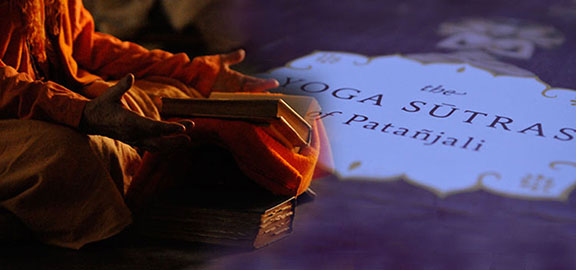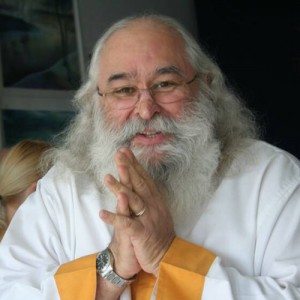 We learn from our study of Yoga and Vedanta that their goals are one and the same: realization of the true Self. Both sages Veda Vyasa, and Sri Patanjali, in his Yoga Sutras, taught that by cultivating viveka (discriminative discernment) the cause of suffering (forgetting our True Self) can be dismantled. In this article, Rev. Jaganath Carrera explains that Viveka is a key concept in Jnana Yoga philosophy. Patanjali first brings up viveka in sutra 2.26. He states that it is viveka that can remove ignorance, and then tells us that by practicing the limbs of Yoga, we attain viveka.
We learn from our study of Yoga and Vedanta that their goals are one and the same: realization of the true Self. Both sages Veda Vyasa, and Sri Patanjali, in his Yoga Sutras, taught that by cultivating viveka (discriminative discernment) the cause of suffering (forgetting our True Self) can be dismantled. In this article, Rev. Jaganath Carrera explains that Viveka is a key concept in Jnana Yoga philosophy. Patanjali first brings up viveka in sutra 2.26. He states that it is viveka that can remove ignorance, and then tells us that by practicing the limbs of Yoga, we attain viveka.
Sutra 2.23. The union of Purusha and prakriti causes the recognition of the nature and powers of them both.
In this sutra, Sri Patanjali suggests a purposefulness to the relationship. The Purusha and prakriti are allies in the phenomenon we experience as life. This alliance forms the foundation for acquiring knowledge. The fundamental consciousness that is the Purusha allows for the perception of objects to take place. And it is the ability of the mind to discern the changing nature of prakriti that leads to gaining knowledge about and realization of the Purusha.
Sutra 2.24. The cause of this union is ignorance.
In the previous sutra, the union of Purusha and prakriti sounded like a nice situation, a source of knowledge. On the relative level, it is. Regardless of how much we learn about the universe and study the nature of the Self, however, as long as we remain ignorant of our True Identity, we are subject to suffering.
Sri Patanjali doesn’t overtly deny that the universe is full of beauty to appreciate and wonders worth exploring. Yet we cannot ignore the fact that nature remains bound by the limitations of its own laws. Sri Swami Vivekananda very eloquently expressed this in his poem, “Song of the Free”:
The beauteous earth, the glorious sun
The calm sweet moon, the spangled sky,
Causation’s laws do make them run;
They live in bonds, in bonds they die.
Until we attain liberation we, as part of nature, are fettered as well.
Sutra 2.25. Without this ignorance, no such union occurs. This is the independence of the Seer.
Yoga practices gradually remove ignorance. With the departure of ignorance, the alliance between Purusha and prakriti ends and, along with it, the mistaken identification of self for Self. The cause of suffering is dismantled and we become liberated beings, jivanmuktas. (See sutra 4.34, which discusses this state in more detail)
The previous eleven sutras (2.15–2.25) presented an important, dynamic and, at times, a seemingly paradoxical understanding of the relationship between the Purusha and Nature. It might prove helpful to review them.
After learning that everything is painful and that the pain can be avoided, we discover that the cause of pain is the union (confusion) of the Seer and seen. But the seen is not stereotyped as a villain. It is Nature expressing in different stages. Though our interaction with it does often result in painful experiences, it also serves to liberate the Purusha, whose nature is pure consciousness. Prakriti’s alliance with the Purusha, though founded on ignorance, is the foundation for knowledge of them both.
When ignorance is erased, the purpose of the seen is ended. Now perceived in a radically new light, it ceases to exist (in the sense of not having any personal relevance) for the yogi. With the elimination of ignorance, the Seer is free. There is no more pain for a realized yogi.
Sutra 2.26. Uninterrupted discriminative discernment is the method for its removal.
Discriminative discernment, viveka, is an innate faculty. In day-to-day life, we know it as the ability to discern the unique characteristics of an object or the distinctions between two or more objects. Ordinarily, our discriminative capacity is occupied with a constant stream of pertinent and non-pertinent thoughts: perceptions of objects, events, wishes and people that flow into consciousness. To pierce through ignorance, however, to perceive the Self as our True Identity, viveka requires a high order of clear, steady focus and the absence of selfish attachment. The more one-pointed our minds become, the more refined, subtle and complete our ability to see becomes. As we continue with meditation, prayer, nonattachment and study, we will be developing not only nirodha (the focusing and stilling of the mind) but viveka as well.
Viveka is the shifting of awareness from the object of perception to the power of perception itself (Purusha). Ultimately it is pure consciousness knowing itself as distinct from any object or experience.
Experience It
The practice of viveka includes recollecting the Truth behind appearances, searching for that which is changeless in that which changes. It is also learning to confront pain in a new way. When disturbed by negative emotions or physical pain, we can ask ourselves who or what it is that feels the pain. “Is it me or my lower back?” “Am I sad, or is it just my mind?” This kind of analysis refines viveka.
Sutra 2.27. One’s wisdom in the final stage is sevenfold.
The practice of viveka changes the way we perceive life. Our perception will reveal a different self and universe from those we knew before.
Sri Patanjali does not list the sevenfold wisdom, though the sage Vyasa does in his commentary. Vyasa’s addition, commented on below, is included in many translations.
Through the practice of viveka, what is to be avoided (the causes of suffering) is recognized. Therefore, there is nothing more to be known on this subject.
For students skillful in viveka, there are no lingering questions regarding how and where happiness will be found. The course has been examined, considered and set. Now all that is left is the journey home.
The causes of suffering having been identified, they are progressively weakened.
This refers to the overcoming of attachments and aversions through the practice of discernment and analysis. When the craving to attain or to avoid anything begins its exit, we can be sure that ignorance is vanishing as well.
(See sutra 2.3, where attachment and aversion are introduced.)
Through samadhi, the causes of suffering are eliminated. There is nothing more to be gained in this area.
Samadhi arrests the causes of suffering. They no longer influence the yogi’s perceptions.
This and the following stage foreshadow the benefits of dharmamegha samadhi, in which all afflictions and karmas cease (see sutras 4.29 and 4.30).
Mastery in viveka having been reached, there is nothing else self-effort can accomplish.
This is the end stage of practice. Self-effort can take the yogi no further. The causes of suffering have been identified, examined, understood, restrained, and then overcome through samadhi.
The following three stages are the natural outcome of the first four and can be regarded as a further explication of sutra 4.34, which describes the final state of independence: Self-realization.
Sattva dominates the functioning of the mind-stuff.
Sattva prevails when the ego subsides. It is illumination, clarity, joy and peace. It is the reflection of the Purusha on the tranquil mind.
(See sutras 1.17, sananda samadhi, absorption on sattva element; 3.36, the distinction between Purusha and sattva; and 3.50, how making the distinction between sattva and Purusha leads to omniscience.)
The gunas, having fulfilled their purpose, lose their foothold like stones falling from a mountain peak and incline toward re-absorption into prakriti.
The feeling of “doership” is no longer falsely attached to the Purusha. The activities of the buddhi become quiet, and the subconscious impression fall away. In essence, mental functioning comes to a standstill. Nirodha is perfected.
(See sutras 4.25 and 4.26, which describe the “pull” of the Absolute; also sutra 4.34, which describes the re-absorption of the gunas into prakriti.)
The Purusha is realized as independent from the gunas (constituents of nature).
The artificial limitations imposed by ignorance and the ego vanish.
Sutra 2.28. By the practice of the limbs of Yoga, the impurities dwindle away and there dawns the light of wisdom leading to discriminative discernment.
Notice the sequence of events:
- The practices of the limbs of Yoga remove impurities. Yoga practices do not bring anything new; they remove what is unwanted or unnecessary.
- As the impurities dwindle, wisdom emerges, indicating that wisdom is already within. In this sutra, the light of wisdom (jnanadipti) refers to insights into spiritual truths. In terms of Yoga practice, wisdom allows for the ability to recognize the goal, set our course on the right track and keep it there.
- Wisdom leads to viveka, which we saw in sutra 2.26 is the method for the removal of ignorance.
About the Author:
Reverend Jaganath Carrera has shared the joy and wisdom of the Yoga Sutras with thousands of students worldwide. A senior disciple of Sri Swami Satchidananda, Rev. Jaganath has taught all facets of Yoga at universities, prisons, Yoga centers and interfaith programs. He established the Integral Yoga Ministry, developed the Integral Yoga Meditation and Raja Yoga teacher training programs and is spiritual head of the Yoga Life Society. His book, Inside the Yoga Sutras is widely available.


